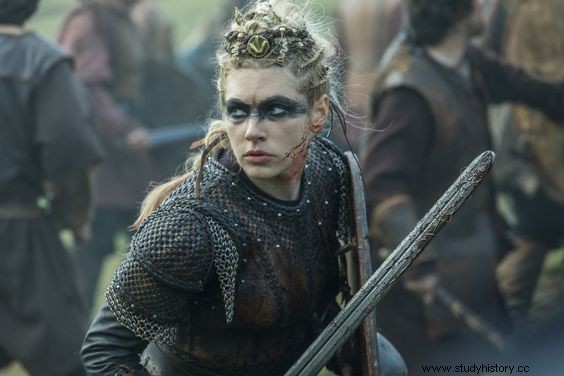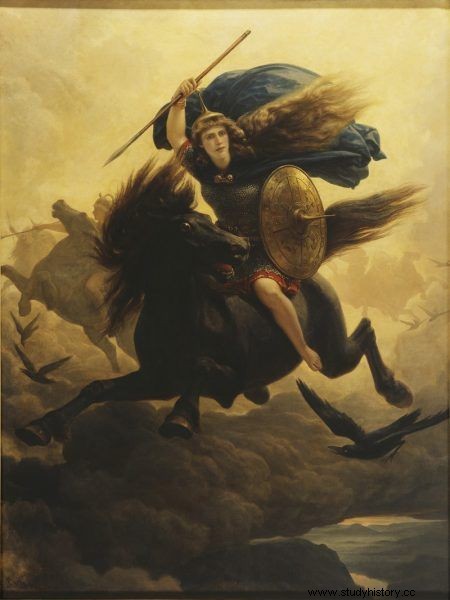The Scandinavian warriors, who were spreading fear and havoc over the vast expanses of medieval Europe, were not alone. Although men dominated in historical accounts, information about women, who were characterized by considerable strength and true bravery, was also recorded in sagas, legends, legends and chronicles. Did the shield guards known from the series "Vikings" exist in reality?
"Experts have long argued as to whether these female warriors really existed or were merely an element of mythology ..." notes Neil Prince, professor of archeology at the Department of Archeology and Ancient History in Uppsala, Sweden. An English researcher points out that women performing heroic deeds, sacrificing themselves for their loved ones or fighting for power could have existed not only in the sagas, but in reality.
Real but legendary
Their classic image comes from texts written much later. The question is how reliable these sources are. It cannot be settled with 100% certainty. Perhaps it is just a fantasy, so it is worth using archeology.
Tangible evidence are artifacts from material culture preserved, for example, in the National Museum of Denmark - we are talking about special pendants from the 9th and 10th centuries, on which two figures have been reproduced - a rider and probably his helper. "They both look female, and most importantly, both are armed." - notes the professor of archeology, who adds that this is a premise to hypothesize about the role women played in medieval Viking reality.
Another piece of evidence may be a figurine of a warrior equipped with a shield and a sword. The image of armed women in art, however, does not seem shocking if we invoke the Valkyries.
Thanks to Norse mythology, we know about the existence of extraordinary goddesses, daughters of the mighty Odin. The Valkyries, which most often had the image of extremely strong, beautiful virgins riding winged horses, were armed with spears and shields. One of the myths about the Valkyries - specifically Brunhild's romance with the warrior Sygurd - served as the basis for the musical dramas included in the tetralogy of Ryszard Wagner's Ring of the Nibelung. In the texts of culture, especially popular culture, there are heroines who can control the mass imagination.
And her name… Lagertha
Lagertha - this is the name of the legendary shieldwoman, considered the ruler of Norway, the wife of the famous Ragnar Lodbrok. We learn about its history from the chronicles written by the Christian chronicler Saxo Grammaticus, who lived at the turn of the 12th and 13th centuries. And it is thanks to him that we learn an extraordinary story about revenge and the fight for freedom.

Lagertha could be real
All thanks to the Swedish king Frø, who invaded Norway, he defeated the local ruler Siward, while all the women of the royal family were sentenced to captivity in a brothel. However, the macabre events had a wide echo in Scandinavia - Ragnar Lodbrok came to Norway to avenge the death of his grandfather Siward, on whose side the women enslaved by Frø stood - the women put on male clothes and took up arms. Their leader was Lagertha. The mythical character has gained in importance - or maybe otherwise, recognition - thanks to the series "Vikings", where female characters are exceptionally strongly represented. Is it historically true?
Answers buried in the grave
The Vikings buried their deceased relatives along with their belongings. The bodies were burned in boats, and along with the burning, one of the warrior's slaves was often killed. Those who fell directly in the fight were led away by the valkyries - goddesses hovering over the battlefield led them to Valhalla, the land of eternal happiness, before the mighty Odin. However, there is at least one well-preserved burial that could change the way we view the role of some women in the Viking community.
'Occasionally we find women buried with weapons, but they have never been typical warrior graves,' comments Professor Prince. And in fact, archaeological discoveries indicate that in the case of the boats with the remains of women, for example, pearls, scissors and brooches were found, and not even a spear, the symbol of the legendary Valkyrie. The more interesting is the discovery in Birka, a medieval town, of a Viking trading post, which is now an important center in research on the culture of medieval warriors.

Peter Nicolai Arbo "Valkyria"
Because in the 1870s a grave was found there filled with various types of weapons - knives, daggers, swords and axes. For many years, the photographs from the find were considered a model example of a male burial. But recently, a team of osteologists, i.e. bone research specialists led by Swedish Anna Kjellstrom, took a closer look at the skeleton from this grave. And so it was established that the skeleton buried there belonged to a woman, which may - but does not necessarily mean - that the deceased was a shieldwoman.
Reconstructing the complete picture of female warriors from the Viking community seems difficult, perhaps impossible. On the one hand, we rely on sagas and legends, and on the other, on material evidence, thanks to which we learn that the shield guards could participate in Viking expeditions. The only question is in what scale and in what capacity. Slaves or goddesses? Legends or historical facts? We will find the answers in the next cycles.
